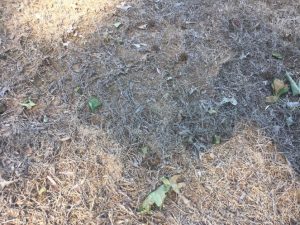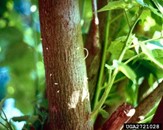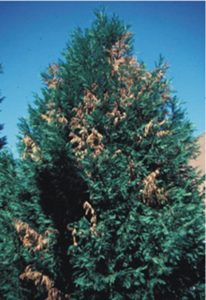
Heather N. Kolich, ANR Agent, UGA Cooperative Extension Forsyth County
Severe and extreme drought afflicted much of the south last year, and 12 metro-Atlanta counties are still under level-2 drought conditions. Because of drought, this spring, we’re seeing delayed green-up in warm-season lawns and numerous issues with trees and shrubs, such as twig and branch dieback, poor flowering and fruiting, and plant death. These issues create continued stress that make plants more susceptible to pests and diseases, which further weaken the plants. Since established trees die slowly over years, secondary aggressors like boring beetles often bear the blame; drought stress, however, is the primary cause of death in these plants.
Lawn recovery advice
Between hot temperatures and low rainfall, warm-season turfgrasses got a double whammy last year. According to University of Georgia turfgrass specialist Clint Waltz, just at the time of year when bermudagrass, zoysia, and other warm-season lawn grasses should have been producing and storing energy reserves for winter survival and spring green-up, they instead went into “conservation mode” in an attempt to survive the summer and fall.
As part of the drought survival response, lawns thin, reducing the number of leaf blades the root system needs to support. In addition to delayed green-up, bare patches are evident in many lawns this spring. To stimulate new growth to cover bald spots, Waltz recommends core aeration.
“If there is ever a year to seriously consider core aerification, this is the year,” Waltz said. “Fortunately, species like bermudagrass and zoysiagrass have stolons and rhizomes, which allow them to tolerate stresses and resume growth once environmental conditions become favorable. For stoloniferous species, the typical result from aerification is increased lateral growth and a healthier plant.”
Waltz recommends aeration with hollow tines that remove cores from a 3-4 inch depth and a half-inch in diameter. This creates a void in the soil that permits water and air to reach the root zone. Eventually the soil relaxes to fill the voids, expanding spaces between soil pores for root growth and better long-term moisture infiltration.
Tree and shrub advice
Like lawns, the vast majority of trees in North Georgia went into dormancy under stress last winter. According to UGA Extension Entomologist Will Hudson, this means that ambrosia beetles and other boring insects will be significant this year.
“Trees leafed and flowered in the spring, then three weeks later, they were dead,” Hudson said.

That burst of production exhausted the inadequate carbohydrate stores in the root systems, leaving trees weak or lifeless.
“Beetles and clear-wing moths are scavengers,” Hudson said. “They look for dead or dying trees. Control once they are in the tree is difficult or impossible.”
For Leyland cypress, arborvitae, and other evergreens thickly planted as living screens, drought stress increases infection from Seridium unicorne, a canker-forming fungus that causes twig and branch dieback. Prune out and destroy infected branches, disinfecting your pruning tools with a bleach solution (1 part bleach: 9 parts water) between each cut to avoid spreading the fungus. Treatment with fungicide is impractical and ineffective.

Dead trees should be cut down before they cause injury or property damage. The Georgia Arborist Association (www.georgiaarborist.org) maintains a listing of certified arborists searchable by county.
Landscape Renovation: Is this the year?
Considering both immediate and prolonged drought-related plant damage, this may be the year to rethink your landscape. While landscape renovations may be low on the home-improvement list, a Virginia Tech study found that a well-designed landscape featuring mature plants and a variety of textures and colors can increase the value of the home by 5.5 to12.7 percent over a landscape that is primarily lawn.
Rather than replacing failing Leyland cypress trees with more of the same, consider a mixed-species planting. Creating a living screen that includes a variety of hardy evergreens provides privacy as well as appealing textures, heights, and colors. Trees and shrubs that flower or produce berries encourage songbirds and pollinators to visit. Biodiversity is also a hedge against total plant loss, since many pests and diseases are host specific. Leyland cypress alternatives include:

Abelia grandiflora ‘Edward Goucher’ and other cultivars – Drought-tolerant abelia grows at a moderate rate to 8’-10’ tall. It takes sun to semi-shade environments and produces white, pink or purple flowers all summer long. ‘Lavender Mist,’ ‘Cloud 99,’ and ‘Raspberry Profusion’ are newer, fragrant cultivars developed by UGA research horticulturalists.
Berberis julianae (Wintergreen barberry) – A slow to medium grower, hardy, drought-tolerant wintergreen barberry has it all: lush green leaves with rich, red fall color, yellow spring flowers, and blue-black berries that it protects with thorns.
Gardenia jasminoides – Ranging from low-growing, creeping ‘Radicans’ to ‘August Beauty’ and ‘Mystery’, which can reach 6’-8’ tall, glossy, evergreen gardenias produce fragrant, white flowers throughout the summer. Best in zones 7b and 8.
Ilex species (Hollies) – Numerous cultivars of hollies mimic the upright, pyramidal form of Leyland cypress trees. Ranging from 10’-20’ high at maturity, these include Mary Nell Holly, Emily Brunner Holly, Foster’s Holly, and Lusterleaf Holly.
Magnolia grandifloria ‘Little Gem’ (Little Gem Southern Magnolia) – A medium-fast growing, narrow magnolia for zones 7 and 8, Little Gem blooms from spring to November.
Pyracantha ‘Mohave’ and ‘Teton’ (Firethorn) – Both of these cultivars are resistant to the two main diseases of Pyracantha – fire blight and scab. Both grow quickly to 12’ in height. Mohave has a 12-foot spread and produces large orange berries; Teton stays a slim 4-feet wide and produces golden-yellow berries. As the common name implies, these shrubs have thorns.
While reducing the extent of home lawns saves water, labor, and money over time, healthy turfgrass makes a welcoming accent to plant-rich landscapes. Now is the time to plant warm-season turfgrass, and Georgia sod producers indicate that sod inventories for bermudagrass, zoysiagrass, and centipedegrass are good to excellent.
Minimizing plant stress is the best protection against pests and diseases. A well-prepared soil bed helps ensure strong root growth for plant longevity. Give new plants a good start by:
- Testing the soil before planting;
- Amending soil as recommended in your soil test report;
- Selecting plants that are appropriate for the environmental conditions of the planting site;
- Planting trees and shrubs in the fall when environmental stresses are lower;
- Mulching around plants to retain soil moisture and reduce competition from weeds and lawn; and
- Providing root-zone irrigation to supplement inadequate rainfall during the first 6-12 months of establishment after planting